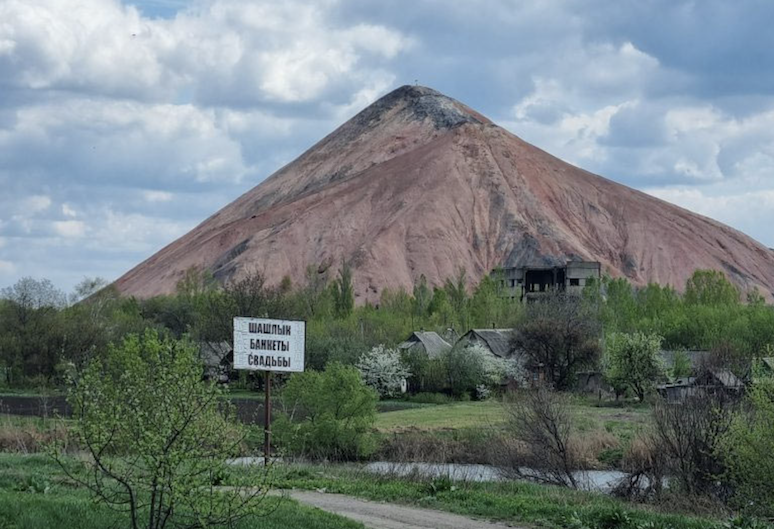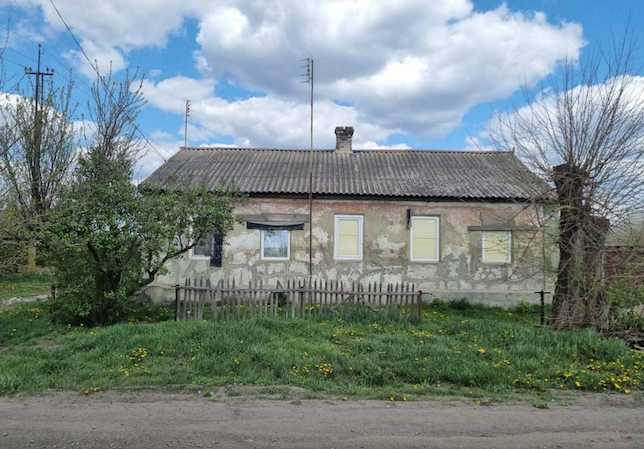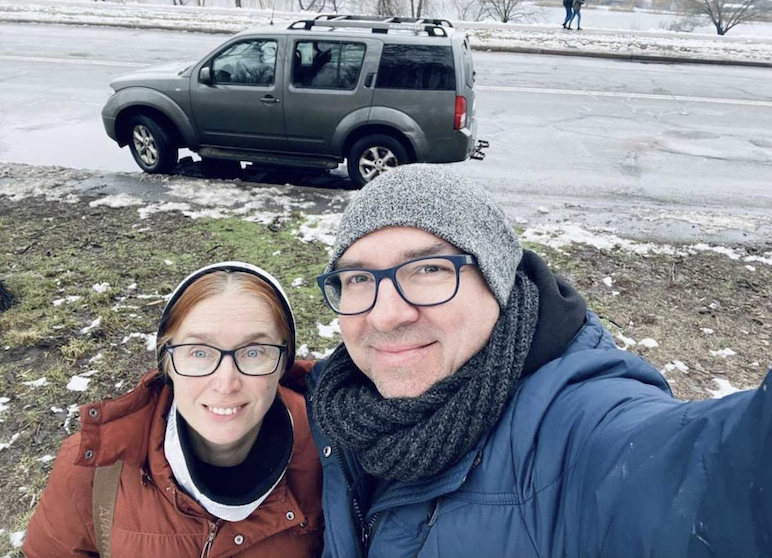During those April weekends, Yuriy packed up his minibus, borrowed from a soldier on leave, to head to the front line with his fellow serviceman Yegor. Their mission over the following weeks was to distribute the gathered aid to relatives, childhood friends, classmates, colleagues, and even strangers—fellow soldiers of the Ukrainian army. Throughout two years, Yuriy embarked on approximately twenty trips, occasionally venturing as close as five kilometres to the front line to visit soldiers resting between tasks or recuperating from injuries.
Yuriy began volunteering in 2014 when his cousin, who had joined the army, needed a thermal imager. In 2022, at the beginning of the full-scale invasion, Yuriy attempted to enlist in the army in Zhytomyr but unsuccessfully. In March, at the funeral of a school friend, the brother of the fallen Ukrainian defender, also a soldier, approached Yuriy. His brigade urgently needed a thermal imager. Since then, he has resumed volunteer trips to the front line.
Yuriy delivers a range of aid: bicycles sourced from Europe through the U-cycle association, printers destined for communities and schools, as well as hygiene products and clothing for civilians. Additionally, he provides military supplies such as thermal imagers, Starlink satellites, drones, tuning equipment, radios, sleeping bags, and robust pickup tyres designed for traversing Ukrainian chornozem, a highly fertile black soil.

Occasionally, Yuriy brings donations on behalf of a humanitarian fund, led by his friend Volodymyr, who has now become a soldier. In between shipments of shampoo and laundry detergent donated by Henkel, Yuriy travels to one of the communities under heavy Russian shelling to assist Volodymyr in signing and certifying administrative documents with his seal.
In May 2015, Davyd Arakhamia, an advisor to the Minister of Defence responsible for volunteer relations, estimated that around 14,500 individuals regularly volunteered. At that time, there were over 2,500 officially registered organisations. According to a survey conducted in September 2014 by the Democratic Initiatives Foundation in collaboration with the Kyiv International Institute of Sociology, one-third of Ukraine’s population donated to the army, while a quarter donated to volunteer organisations. According to a 2016 survey by the Gorchenin Institute, 71% of Ukrainians trusted volunteers, 42% trusted local authorities, only 8% trusted parliament and 5% trusted the courts.
Since then, the army has made significant progress, improving supply chains, equipment, and services. The full-scale Russian invasion on February 24, 2022, was a pivotal moment that further galvanized civil society and the volunteer movement.
According to the Ministry of Defence, between 2022 and 2023, Ukrainian volunteers raised over 2.3 billion euros to support the military, excluding material donations. In December 2023, the Sergey Prytula Fund announced that it had raised two billion over the span of two years, with an average donation of 800 hryvnias. Additionally, in 2023, Ukraine once again climbed the ranks in the World Giving Index, moving from tenth to second place globally after Indonesia and overtaking Kenya.
Yuriy signed up at the onset of the full-scale invasion, yet it was his return to volunteering that truly instilled in him a sense of contribution to collective efforts and facilitated his regaining of inner peace. Travelling in person isn’t strictly necessary; with Nova Poshta mail service boasting over 27,000 hubs nationwide, the task could be handled entirely remotely. However, these brief encounters on the road, in rural dwellings where soldiers are stationed, and in small towns along the front line, offer at least some opportunity for conversation with loved ones who have joined the army and whom one might only catch a glimpse of during brief and infrequent leaves. Volunteer trips also serve as a means to reminisce about mutual friends, discuss updates from civilian life, and uphold connections, providing invaluable support. It’s one of the ways that effectively bridges the gap between military personnel and civilians.
Conversations touch on everything. “Oh, these housing prices have skyrocketed!” complains a soldier near Pokrovsk. Houses were renting for 12,000 hryvnias per month, but after the area was struck by KABs, the Russian guided bombs, the rent dropped to 7-8,000 hryvnias, and local residents moved to safer areas.
Travelling along the road, speckled with military gear and shellings, demands considerable expertise. Residents strive to make ends meet, selling dried and salted fish from nearby water bodies, homemade jams, and fruits along the roadside.
You’ll encounter an array of vehicles from across the globe on the journey, including Ukrainian ZAZ cars, armoured vehicles, Soviet-era Zhigulis, UAZs, and vintage buses reminiscent of those seen in Soviet films. These vehicles are registered in various countries like Germany, Belgium, and the United Kingdom.

Donbas coal-mining spoil tips
They circulate among the symbolic slag heaps—remnants of coal mining in the region. Some of these mounds are already overgrown with grass and weathered, while the more recent ones take on the appearance of pyramids with staircases. Nearby, you’ll find tidy homes adorned with flower beds, flourishing cherry trees, and playgrounds for children. Yet, the windows are shuttered with plywood. And amidst it all, fields are sown… Despite the ongoing war and the looming danger.
Tetyana Ogarkova and Volodymyr Yermolenko, literature and philosophy professors at Kyiv-Mohyla Academy, are also the founders of podcasts discussing Ukraine and Ukrainian culture in Ukrainian, English, and French. Their journey into volunteering began in April 2022 when the Brovary City Council assigned them the responsibility of distributing humanitarian aid. Despite the generous donations received, delivering aid to the twenty-seven villages in the region proved to be a challenge due to transportation shortages. Unfortunately, most of these villages came under occupation in the initial months of the war.
The Ukrainian PEN, led by Volodymyr, also organises trips to the regions. The couple decided to allocate donations from subscribers to their podcast Kult (which amounted to about £4000 per month at that time) to purchase optical sights and collimators. To streamline their efforts, they later decided to focus on purchasing vehicles, which are in high demand at the frontlines.
The first car was bought and delivered in autumn 2022 following the liberation of the Kharkiv region. By the start of this summer, Tetyana and Volodymyr had funded, acquired, and transported approximately thirty cars and, more recently, even a truck. A former mechanic and the Kolo Foundation assist them in sourcing vehicles, repairing them, and delivering them to Brovary, where the couple takes charge of transporting them to the front line. Occasionally, soldiers seize the chance to leave their posts and head to the capital for a brief respite of several days, aiming to change their surroundings and personally collect the vehicle.
Tetyana and Volodymyr cherish the opportunities to journey to the front lines. “Delivering cars for us isn’t just about logistics; it’s a chance for conversations, gathering testimonies, and capturing moments on film. Being physically present is crucial for us, to witness this reality,” explains Tetyana. “Sometimes a meeting lasts only five minutes: a quick exchange of keys and paperwork. But there was even a time when we spent the night with the soldiers. There’s a genuine need for communication among both soldiers and civilians in these areas, and this exchange is invaluable.”
The couple has forged bonds with the returning residents of destroyed villages, like Kamianka near Izyum in the Kharkiv region. They regularly visit an elderly farming couple from Velyka Novosilka, who tend to sheep amidst the rubble just ten kilometres from the southern front line. Living without electricity, they rely on a rural generator to charge their phones and welcome guests from Kyiv with their homemade preserves.

Windows boarded up with plywood, Donbas
“These journeys really open your eyes to so much,” Tetyana reflects. “You return filled with renewed motivation—to keep dreaming, to keep volunteering, to keep pushing forward… It’s like finding the answer to what a person can truly be at their very best, especially in the face of adversity, and it reminds you of your own capabilities. It’s like an antidote to losing motivation.”
During their recent journey to the Ostriv district of Kherson city, which Tetyana describes as a “triple-martyr city” due to its history of occupation, flooding, and ongoing shelling by Russians across the Dnieper,” the couple brought books from the Ukrainian PEN destined for the book shelters established by the city hall. In one of the buildings in the perilous microdistrict, with 120 apartments spanning 10 floors, only 11 people remain, including Anton and his 22-year-old nurse girlfriend. “This is all we can afford on a nurse’s salary,” the young woman explains. “We can’t afford to rent in a safer area, and there aren’t many opportunities to make a living in this city. But at the same time, we don’t want to leave.”
“Staying put is also a form of resistance,” Tetyana asserts, “because the Russians are actively trying to coerce Ukrainians into leaving.”

Tetyana and Volodymyr with the newly delivered English right-hand drive Nissan Pathfinder in Kherson

